Catalogue > Faire une recherche
Résultats pour : Tout le catalogue

Anna Baranowski, Vlad Br?teanu
Fill In The Blanks
Film expérimental | 4k | couleur | 11:5 | Roumanie, Allemagne | 2022
Anna Baranowski and Vlad Br?teanu’s collaborative piece invites the audience to experience an intimate hypnotic induction. By making use of the hypnotic methodologies of relaxation - the sound of the sea and the soft human voice; images from the seaside, and the notions of rest and recovery that vacation recalls - the artist’s voices smoothly induce into the visitors’s consciousness local stories and realities of global warming, massive migration and economic challenges inflicted by global politics and mass tourism from Radhima, Vlora, a small village at the tip of the Albanian Riviera.
Anna Baranowski was born in Bytom, Poland in 1983. Today she lives secluded in a small village surrounded by the forests of East Germany and works on her art. In 2012, she received her diploma in media art with distinction from the Academy of Visual Arts in Leipzig. After her studies, she took part in numerous exhibitions in Germany and abroad, such as the Berlin Biennale „Forget Fear“ in 2012. She has received grants, such as the Stiftung Kunstfonds working scholarship in 2018, and in recent years has been invited to various artist residencies, such as the Greater Columbus Arts Council in Columbus, USA, to develop new artistic works. Anna Baranowski looks at historical legacies in contemporary everyday life and reflects on collective psychological phenomena of human behaviour. In the field of experimental and documentary film, she focuses on direct cinema. She always uses documentary material in her works. In addition to her own cinematic images, composed in detail, the use of archival material is a central element of her experimental films. In doing so, she uses a wide variety of sources, such as amateur recordings, NASA or military footage. By taking them out of their original context, her works release new meanings. With documentary images that depict the real world, Anna Baranowski tells fictitious stories that are irritating and contrary to obvious expectations, which is precisely why they have an inner meaning and for this very reason trigger processes - the viewer is thrown back on himself and is confronted with his own feelings. Vlad Br?teanu, born in Bac?u, in the former Socialist Republic of Romania (RSR) in 1986, currently lives and works in Berlin, Germany. Br?teanu holds a M.A. in Photography and Moving Image and a B.A. in Graphics from the National University of Arts in Bucharest. In 2016 he studied Philosophy in the Context of Contemporary Art at the Royal Institute of Art in Stockholm. His background in graphics forms the base for theoretical and conceptual considerations in which photography functions as a primary medium. Sound/hypnotic inductions, found objects, and public interventions that use playful semiotics of imagery are found in his current practice. Navigating the boundaries between public and private spaces, and finding signifiers for (in)visibility are translated into works that raise questions on precarity, fragility and stability in neoliberal societies. Research into the concept of plasticity and the effects of language are central in his artistic practice. Vlad is the co-founder of Template, an artist initiative and exhibition project that started in Bucharest in 2018 and is an alumnus of WHW Akademija in Zagreb in 2020.

Theodora Barat
(Atomic) Four Corners
Documentaire | 4k | couleur | 25:0 | France, USA | 2024
In New Mexico USA, a group confronts the environmental racism engendered by nuclear research and uranium mining. Fighting against government narratives that conceal this reality in museums and tourist sites, women refuse to be silenced.
Born in 1985 in the Paris region, Théodora Barat is a visual artist and a director. She studied at the Beaux-Arts de Nantes before joining the Fresnoy – Studio National des Arts Contemporains and was a resident at the Villa Medici last year. She’s now a teacher at the Beaux-Arts de Nantes. Her work, around sculpture and video installation, has been presented at the Nuit Blanche (Paris), Cneai (Paris), the Emily Harvey Foundation and the Elizabeth Foundation for the Arts (New York), the Friche de la Belle de Mai (Marseille), Mains d’Oeuvres (Paris), Glassbox (Paris), and the CAC Vilnius (Lithuania), as well as in video programming at the Palais de Tokyo. She directed two previous documentaries in 2018 (“Pay Less Monument”, shot in New Jersey, USA and winner if the Audit talent award 2016) and in 2021 (“Off Power”, shot in Hong Kong), both selected at Cinéma du réel.
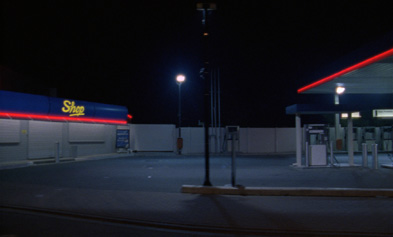
Théodora Barat
On anything at all except the dark pavement
Vidéo | hdv | couleur | 5:0 | France | 2011
Or anything at all except the dark pavement est un travelling nocturne réalisé en 16mm. Un plan séquence en deux moments. D?abord une avancée en sentinelle dans la ville. Une percée dans la nuit, quelques néons comme guide, un phare latéral comme repère. La ville, déjà vague, s?estompe, l?obscurité lui succède et découvre un paysage lumineux, une autre « skyline ». Des éléments de mise en scène surgissent et offrent d?autres évènements. Ils sont aussi en référence : la ville traversée et son architecture évoque l?aspect « hangar décoré » de la ville américaine de nuit ; le soudeur, est une allusion à la scène d?entrée de Double Indemnity de Billy Wilder, premier Film Noir ; les éléments de chantier sont en rapport direct avec un texte de Tony Smith qui relate une virée nocturne sur une autoroute en construction dans les années 50, récit d?où est tiré le titre du film? Une vision fantasmée de paysage de bords de route
Théodora Barat a suivi un cursus de 5 années aux Beaux Arts de Nantes. Nourri par de nombreux voyages aux États-Unis et par le cinéma américain des années 50`s, son travail s`est peu à peu dirigé vers l`installation et spécialement l`installation vidéo. Elle réalise en 2008 Froissée, la première d`une série d`installations autour du Film Noir et de la représentation de la ville dans ce genre cinématographique. Suivront Underworld (2009) et Projection Frontale (2010). Elle réalise cette année son premier film, un plan séquence tourné en 16mm, diffusé sous la forme d`une installation et d?un film.

Theodora Barat
Panorama zero
Film expérimental | | couleur | 9:26 | France | 2013
Panorama zéro est une progression nocturne dans lieu incertain. Le film commence dans une obscurité presque totale, puis l`espace commence à se révéler, à être de plus en plus construit et luminescent. Il retrace un parcours entre nuit ambiante et éléments lumineux surgissant, et rend l`incapacité à cartographier cet espace, en donnant une impression floue et sibylline, un ressenti.
Le travail de Théodora Barat se situe entre le cinéma et les arts plastiques touchant à la fois à l`installation, à la vidéo et au film. Elle a étudié aux Beaux-Arts de Nantes avant d`intégrer le Fresnoy - Studio national des arts contemporains où elle a réalisé son premier film Or anything at all except the dark pavement, diffusé sous la forme d`une installation et d?un film. Elle est la lauréate de la résidence d`artiste de Côté Court pour l`année 2012-2013.
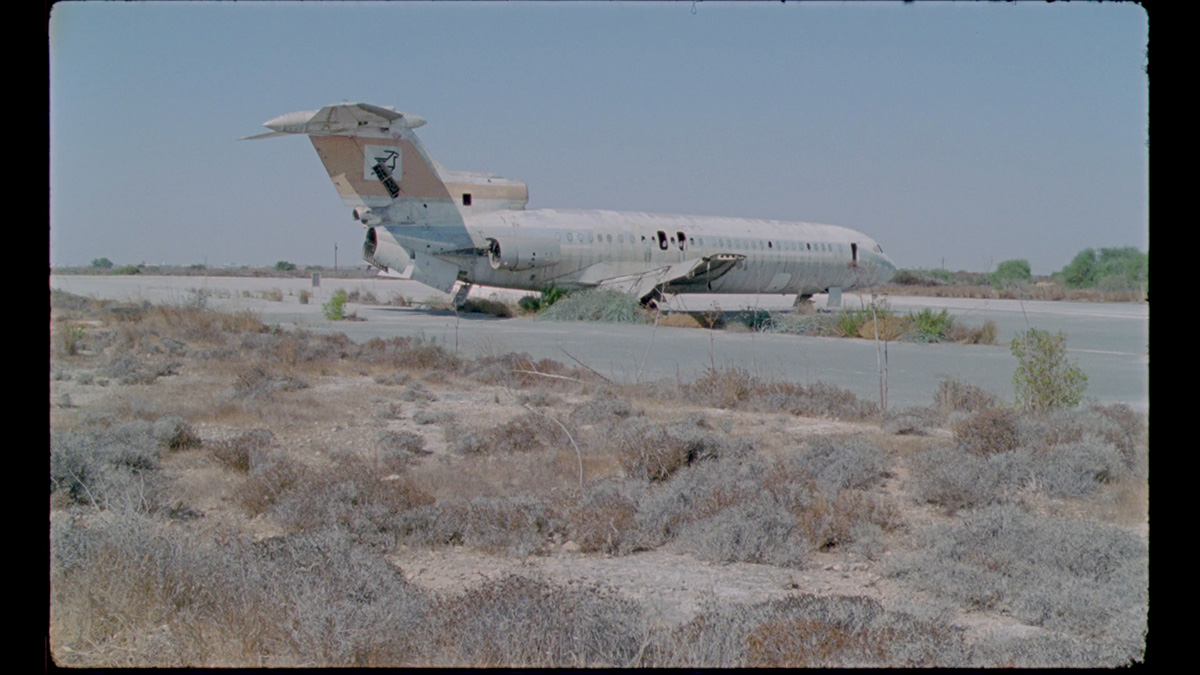
Rosa Barba
Inside the Outset: Evoking a Space of Passage
Film expérimental | 35mm | couleur | 0:0 | Italie, Chypre | 2021
Inside the Outset: Evoking a Space of Passage is a project by artist and filmmaker Rosa Barba following an invitation by Point Centre for Contemporary Art in Nicosia and curator Mirjam Varadinis to propose and realize a project in Cyprus. The work proposed by the artist in 2013, started in 2014 and consists of two parts: a film and a long-term open-air cinema installation. The project was then presented to the Italian Council and received the first prize at the international competition (Third Edition) in 2018, and was awarded a grant from DGAAP (Directorate General for Contemporary Art and Architecture and Urban Peripheries), Italy. Barba’s film is exclusively shot in Cyprus, including underwater shots of the Mazotos shipwreck, as well as aerial shots from archaeological sites. It is an investigation into the loaded, transforming topography that is already palpable in the landscape, before we actually understand what language it creates for our society. In that, the film follows Barba’s artistic approach to examine liminal states which manifest in between contested spaces, both mentally and geographically, in order to allow for a new perspective. The inaugural screening took place in Autumn 2021 at the open-air cinema installation in the Buffer Zone.
Rosa Barba (b. 1972 in Italy) lives and works in Berlin. Rosa Barba studied at the Academy of Media Arts in Cologne and at the Rijksakademie van Beeldende Kunsten in Amsterdam. Barba’s work is represented in numerous international collections such as Collezione MAXXI Arte, Rome, Italy; Collezione FRAC Piemonte, Vercelli, Italy; Hamburger Bahnhof, Berlin; Lemaître Collection, London; Louisiana Museum of Modern Art, Humlebæk, Denmark; Museo di arte moderna e contemporanea di Trento e Rovereto, Rovereto; Museo Centro de Arte Reina Sofía, Madrid, Kunsthaus Zürich, MACBA Barcelona, Mambo Bologna, Sammlung zeitgenössischer Kunst der Bundesrepublik Deutschland Germany and Jumex, Mexico City. She has participated in group shows amongst others at MASS MoCA, USA; Akademie der Künste, Berlin; Kunstmuseum Liechtenstein, Vaduz; La Cinémathèque Française, Paris; WIELS, Brussels; Museo Nacional Centro de Arte Reina Sofia, Madrid; Swiss Institute, New York; 8th Berlin Biennale for Contemporary Art International Triennial of New Media Art 2014, Beijing, China; 19th Biennale of Sydney; International Biennial of Contemporary Art of Cartagena de Indias, Colombia; 2010 Liverpool Biennial; 52nd and 53rd Venice Biennale; 2nd Thessaloniki Biennale of Contemporary Art; Biennial of Moving Images, Geneva.

Rosa Barba
From Source to Poem
Film expérimental | 35mm | couleur | 12:0 | Italie, Allemagne | 2016
"From Source to Poem" is an invitation to think about the spaces in which history and cultural production is preserved in order to be passed on to future generations. On the one hand, it pursues Barba’s research initiated with "The Hidden Conference" (2010-2015) “a three-part film work exploring museum storages and whose title refers to imaginary conversations taking place between artworks inside these invisible spaces” on the other hand, it is a reflection about the obsession of preserving any output of western culture in any possible medium. "From Source to Poem" shifts the focus from artworks into archival storage: Shot at the National Audio-Visual Conservation Center of the Library of Congress in Culpeper, Virginia, and at an enormous solar power plant in the Mojave Desert in California, it juxtaposes images from the largest media archive worldwide with a study of rhythm, and images of cultural with those of industrial production. The film exposes the preservation of cultural outputs, but also their digitisation for the future. A vast number of the archive’s holdings are sound material; a sonic memory which is recovered and mixed in the soundtrack as a mean to set in motion otherwise unlikely dialogues. Filmed and screened on 35mm film, the work itself is preserved in one of the most durable archival forms.
Rosa Barba’s work is a subtle interrogation into and co-option of industrial cinema-as-subject, via various kinds of what might be understood as “stagings”—of “the local,” the non-actor, gesture, genre, information, expertise and authority, the mundane—and removals from a social realism within which they were observed, and which qualifies them as components of the work, to be framed, redesigned, represented. The effect of which her work contests and recasts truth and fiction, myth and reality, metaphor and material to a disorientating degree, which ultimately extends into a conceptual practice that also recasts the viewer’s own staging as an act of radical and exhilarating reversal – from being the receiver of an image (a subject of control) to being in and amongst its engine room/s, looking out. (Ian White)
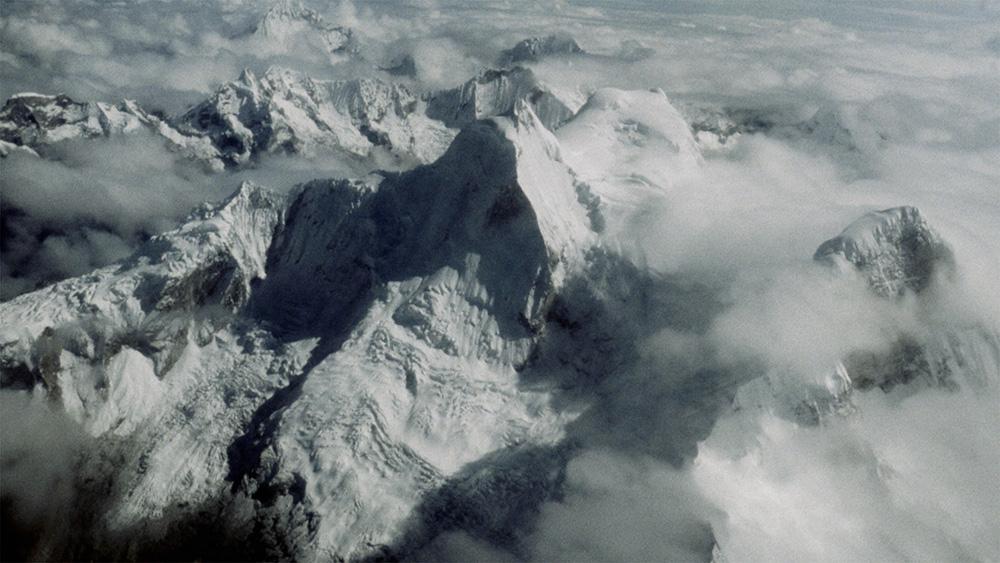

Rosa Barba
Aggregate States of Matters
Doc. expérimental | 4k | couleur | 21:22 | Italie, 0 | 2019
L’état des lieux met en évidence la relation ambiguë entre l’homme et la nature. Pour son nouveau film en 35 mm tourné au Pérou, Rosa Barba a travaillé avec des communautés qui sont touchées par la fonte d’un glacier et les temps géologiques qui sont mis à nu. Barba montre la lente disparition du glacier et la perception de ce fait au sein de la population Quechua des Andes. Tout en explorant les différents mythes locaux, elle souligne la possibilité de traduire les connaissances anciennes dans le temps présent.
Rosa Barba est née en 1972 en Italie, vit et travaille à Berlin. Elle a fait ses études à l'Académie des arts et médias de Cologne et à la Rijksakademie van Beeldende Kunsten à Amsterdam. Le travail de Barba est représenté dans de nombreuses collections internationales telles que la Collezione MAXXI Arte à Rome en Italie, la Collezione FRAC Piemonte à Vercelli en Italie, le Hamburger Bahnhof à Berlin, la Collection Lemaître à Londres, le musée d'art moderne Louisiana à Humlebæk au Danemark, le Museo di arte moderna e contemporanea di Trento e Rovereto à Rovereto, le Museo Centro de Arte Reina Sofía à Madrid, la Kunsthaus à Zurich, le MACBA à Barcelone, le Mambo à Bologne, le Sammlung zeitgenössischer Kunst der Bundesrepublik Deutschland en Allemagne, et Jumex à Mexico. Elle a participé à des expositions collectives, notamment au MASS MoCA aux États-Unis, à l'Akademie der Künste à Berlin, au Kunstmuseum du Liechtenstein à Vaduz, à la Cinémathèque Française à Paris, au WIELS à Bruxelles, au Museo Nacional Centro de Arte Reina Sofia à Madrid, au Swiss Institute à New York, à la 8e Biennale d'art contemporain de Berlin, à la Triennale internationale en arts des nouveaux médias 2014 à Pékin en Chine, à la 19e Biennale de Sidney, à la Biennale internationale d'art contemporain de Carthagène en Colombie, à la Biennale 2010 de Liverpool, aux 52e et 53e Biennales de Venise, à la 2e Biennale d'art contemporain de Thessalonique et à la Biennale de l'image en mouvement à Genève.
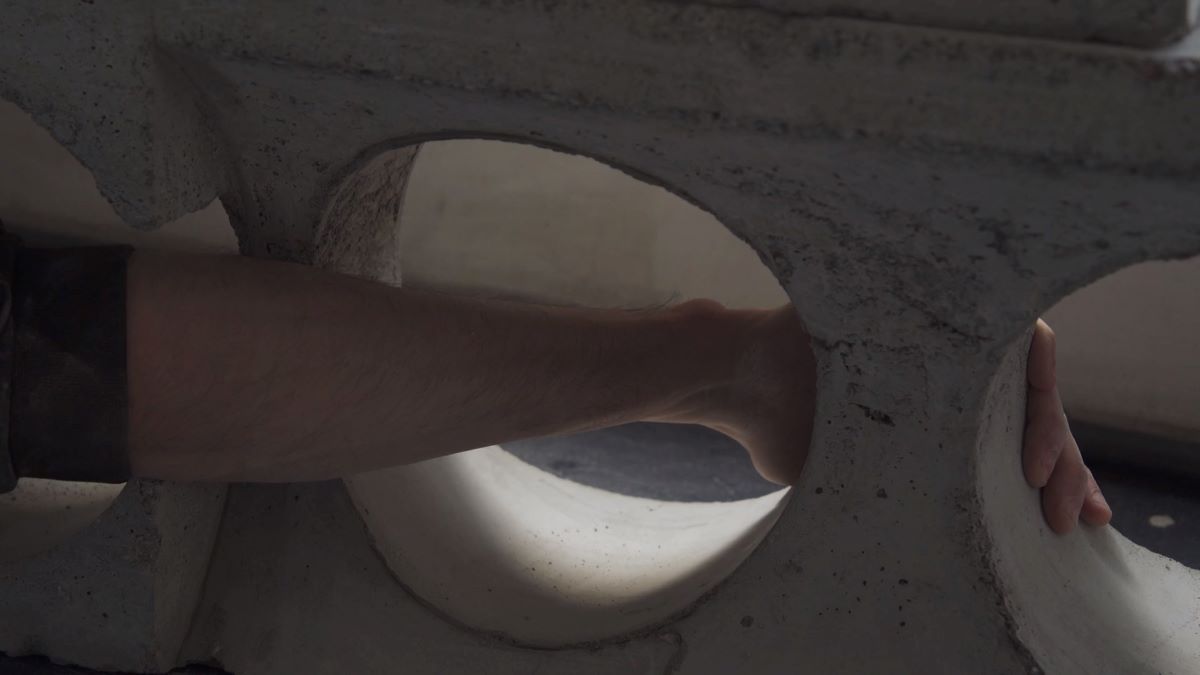

Maddi Barber, June Crespo
CORE
Film expérimental | mov | couleur | 21:22 | Espagne | 2022
Someone is sleeping. A conveyor belt moves stones in an underground place. The stones fall through a hole in the shape of a mouth. Some hands go through a piece of concrete. Someone operates a knob that crushes the stone. In CORE, we document the different states through which the material passes: stone, dust, liquid and solid. Moving between the surface of things and underneath them, we interweave two apparently distant processes: hands traversing and manipulating cement sculptures and the process of extracting and transforming stones in a quarry. An encounter and friction between materials that is in turn the result of the meeting and negotiation of two languages, the sculptural and the cinematographic.
JUNE BIO June Crespo (Pamplona 1982) graduated in Fine Arts from the University of the Basque Country in 2005 and participated in the De Ateliers residency programme (Amsterdam 2015-2017). Her solo exhibitions include: entre alguien y algo (2022) and Ser dos (2017) at CarrerasMugica gallery, Bilbao; Helmets (2020) at Artium, Vitoria-Gasteiz; Voy, sí (2020) Heinrich Ehrhardt gallery, Madrid and No Osso (2019) at Uma Certa Falta de Coêrencia, Oporto. She has recently participated in group exhibitions such as: The Milk of Dreams, Venice Biennale 2022; Fata Morgana, Jeu de Paume (Paris) or El sentido de la Escultura at the Miró Foundation (Barcelona). MADDI BIO Maddi Barber (Valle de Arce, 1988) has a degree in Audiovisual Communication and an MA in Visual Anthropology from the University of Manchester. Her work has been shown at festivals such as Visions du Réel, FidMarseille, San Sebastian (Zabaltegi), Curtocircuito, Zinebi, Ji.hlava, Porto Post Doc and Las Palmas, among others. They have also been exhibited in museums and centres such as La Panera, Artium and the Oteiza Museum. She is currently working on the development of his first feature film, "Claros de bosque".

Maddi Barber, Marina Lameiro
Cambium
Doc. expérimental | 16mm | couleur | 44:30 | Espagne | 2024
CAMBIUM, the cellular stratum of trees, it’s a cambial membrane that runs along the trunk and roots, producing growth. In the Navarrese Pyrenees a community has decided to cut down a pine forest in order to recover ancient fields for cultivation and animal grazing. Structured in two parts, the film traces the change of a territory traversed by practices of violence and care for the land.After the abandonment of the villages during the 1960s in the Arce Valley, the Government of Franco planted pines in the fields that were used for grazing as part of a state programme of reforestation and forestry. More than 50 years later, in Lakabe, a village repopulated in the 1980s, they have decided to cut down the pines and recover their meadows for livestock. Through different data capture and image technologies, CAMBIUM explores, together with the inhabitants of the area, a territory in transformation.
Maddi Barber studied audiovisual communication at the University of the Basque Country and did a master's degree in visual anthropology at the University of Manchester. In 2019 she created the production company Pirenaika, with which she has produced some of her films as well as those of other artists and filmmakers from the nearby context such as Gerard Ortin, Ainhoa Gutiérrez and Irati Gorostidi. Her latest co-production, CONTADORES, by Irati Gorostidi, had its international premiere at the Semaine de la Critique in Cannes. She is currently participating in Tabakalera's Ikusmira Berriak residency, where she is developing the feature-length fiction film CLAROS DE BOSQUE. Marina Lameiro is a filmmaker and producer. She holds a degree in Audiovisual Communication from the URJC and a master's degree in Creative Documentary from IDEC-UPF and a postgraduate degree in Audiovisual Editing from the same university. She was part of the Collaborative Studio (CoLab) of UnionDocs in New York City as an artist-in-residence. In 2018 he released her first feature film YOUNG & BEAUTIFUL which, among other awards, won the Special Audience Award at the Punto de Vista Festival in 2018, was nominated for the Feroz Awards and has been screened in more than 20 countries. In 2021 she released DARDARA, her second feature film, which entered the list of the 10 most-seen films in cinemas after its premiere at the Punto de Vista Festival.
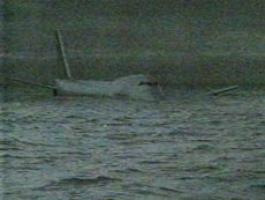

George Barber
What's that sound?
Vidéo expérimentale | dv | couleur | 4:0 | Royaume-Uni | 2004
George Barber doffs his cap to the 20th anniversary of Scratch Video with What`s That Sound?, a mesmerizing montage of questions, answers, and the cries and screams of people caught in a disaster movie. The work uses as its starting point, the film Airport `77 where, improbably, a jumbo jet sinks to the bottom of the sea. What follows is a clever amalgamation of absurd linguistics, cries and shouts, highlighting the artist`s permanent fascination with speech, and human reaction to out-of-the-ordinary situations.
Courtesy Video Data bank
www.vdb.org
"What`s that Sound?" is a piece started in 1989 but not finished until 2004. The piece is a re-working of "Airport 77" disaster movie. The Artist focuses on a scene where the occupants of a plane, stranded at the bottom of the sea, are listening desperately for any signs of rescue. Vincent Price and Jack Lemmon star. Slowly a link is made between the audience listening - and those on the plane listening. We struggle like them to hear and are drawn in. The extraneous sounds of life start to become part of the work."
Courtesy www.luxonline.org
"George Barber was born in Guyana in 1958. He studied at St Martins and Slade Schools of Art, London. He was a founder member of ZG Magazine and a leading figure in the Scratch Video phenomenon of the 80s, which exploited newly available video-editing technologies and their potential for rhythmic-editing and moving-image collage. His current work is visually striking and sometimes disturbing, and often concerned with human behavior in unusual situations. He was once described by Art Monthly as, "The Henry Ford of independent video." Courtesy Video data bank

Nora Barbier
Les Yeux bleus cheveux noirs
Fiction expérimentale | hdv | couleur | 14:31 | France | 2017
Deux amis se filment dans Shanghai. Librement inspiré du livre éponyme de Marguerite Duras, Les Yeux bleus cheveux noirs est un film sur le regard,le désir : une lutte silencieuse dans laquelle la retenue l’emporte sur ce qui est livré.
Nora Barbier est née en 1988. Après des études en philosophie contemporaine (Philmaster ENS et EHESS) et en études de genre (M2 de l’Université Paris 8 Saint-Denis), elle a travaillé comme attachée de production de cinéma pour Capricci. Sa première exposition personnelle, Life is so Easy, a eu lieu au Bazaar Compatible Program à Shanghai en 2016.
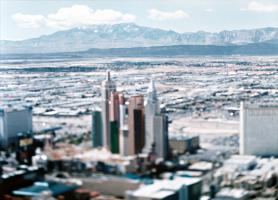

Olivo Barbieri
site specific_LAS VEGAS 05
Film expérimental | 35mm | couleur | 12:30 | Italie, Canada | 2005
Las Vegas, ou l?apothéose de la ville en plein désert. Visiter Las Vegas au milieu des années 60 était l?équivalent du voyage à Rome à la fin des années 40? « Learning from Las Vegas" Venturi, Brown, Izenour. The M.I.T. Press, 1972,1977. Trente-trois ans après la publication du célèbre traité d?architecture de Robert Venturi « Learning from Las Vegas », comment cette ville apparaît-elle aujourd?hui? Las Vegas 1905- 2005 : un siècle après sa fondation, quelle est la forme de Las Vegas, première ville au monde en termes de tourisme et de divertissement de masse et qui semble imperméable aux différentes crises énergétiques (pétrole, eau, électricité) et menaces terroristes qui touchent le monde moderne ? «site specific_LAS VEGAS 05" est un projet artistique, une ?uvre en cours de réalisation, la deuxième étape d?un voyage commencé à Rome et qui nous amènera ensuite à Shanghai.
Olivio Barberi est né en 1954 en Italie et commence à exposer en 1978. À partir de 1989, il effectue des voyages réguliers en Orient, surtout en Chine. En 1993, 1995 et 1997 il participe à la Biennale de Venise et à de nombreuses manifestations internationales d?arts visuels contemporains. En 1996, le Folkwang Museum d?Essen lui consacre une rétrospective. En 2003, il participe à «Strangers », la première triennale de photographie et de vidéo organisée par le Centre International de la Photographie ICP à New-York. En 2003, il entreprend le projet site_specific qui s?intéresse à plusieurs villes dont Rome, Montreal, Amman, Las Vegas, Los Angeles, Shanghai et Séville. Dans le cadre du film site_specific, il réalise trois films : site specific_ROMA 04, site specific_LAS VEGAS 05, site specific_SHANGHAI 04. En 2005, il commence une nouvelle série de films intitulée Seascape # e Riversacape #. En 2006 la BIACS (biennale de Séville) l?invite à réaliser un nouveau film, Se villa → ( ∞ ) 06. Les ?uvres d?Olivio Barbieri sont présentées dans des musées, des universités et des collections en Europe et aux États-Unis. De nombreux ouvrages ont été publiés sur son ?uvre dont Paesaggi in Miniatura, Art& Udine 1991 ; Notte, Art&, Udine 1991 ; Olivo Barbieri seit 1978, Museum Folgwan, Essen 1996 ; Artificial Illuminations, Smithsonian, Washington, D.C., 1998 ; Virtual Truths, Silvana Editoriale, Milano 2001 ; Notsofareast, Donzelli, Roma 2002 ; Site Specific_Roma 04, Zoneattive, Roma 2004 ; Site Specific_Las Vegas 05, Wonder Inc., Toronto 2005 ; site specific_SHANGHAI 04, Editrice Quinlan, Bologna 2006 ; site specific_NYC 07, APM edizioni, 2007.
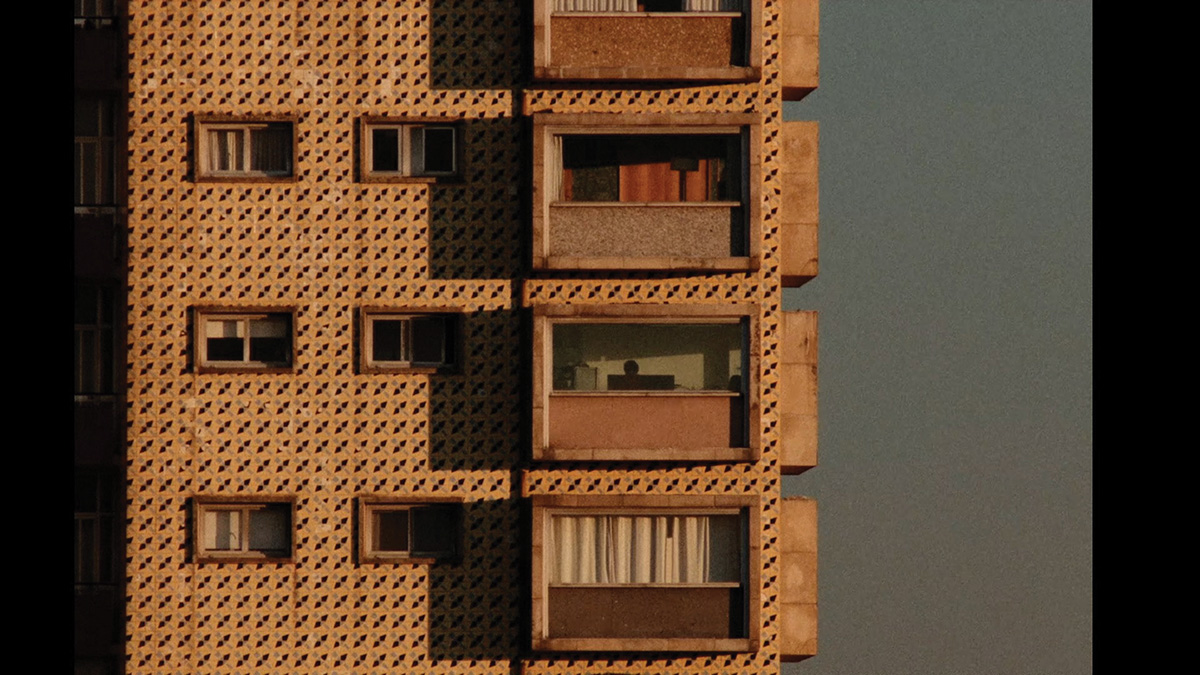

Rita Barbosa
2ª Pessoa
Vidéo | 4k | couleur | 16:0 | Portugal | 2022
One day, an old water pipe caused a ceiling leak. On this ceiling, toxic mushrooms of the order Polyporales would grow. Sitting on the toilet, the lady of this house looks up and observes that magical and mysterious fungus, which is not an animal, nor a plant. The mushroom is the future, she thought.
1979. Graduated in Digital Arts, in Sound and Image Course, by the School of Arts of UCP (2002). She completed her training with courses and workshops such as the Maine Media Workshops Photography Management Workshop. She wrote and performed her first short film FRIENDS AFTER DARK [2016], that had it international premiere at the 69th Locarno Film Festival, and was screened at film festivals such as Curtas de Vila do Conde, Márgenes, Curtas de Verin, SACO - Oviedo Contemporary Audiovisual Week, FICA - Aguilar del Campo Film Festival, Cinema Jove, Luso Brasileiro de Santa Maria da Feira, and in other exhibitions of which Bilbao Arte stands out. She wrote and staged the film-performance AMIGOS IMAGINÁRIOS [2018], with the collaboration of Rui Lima, Sérgio Martins and Jonathan Saldanha, with a premiere scheduled at Teatro Rivoli (2019). In theater, dance and performance she collaborated in the creation, set design, visual design, video and dramaturgy of several projects, including TRÊS DEDOS ABAIXO DO JOELHO (2012), by Tiago Rodrigues, that won Best Play in 2012 by the SPA, presented internationally in Kunsten Festival Des Arts, De Internationale Keuze and Rotterdamse Schouwburg, STAGE, Théâtre de la Ville, Théâtre des Abbesses, Emilia Romagna Theater Fondazione, among others. She collaborated in the plays: SABOTAGEM (2015), by Lígia Soares, Miguel Castro Caldas and Sílvia Pinto Coelho; O ESPLÊNDIDO (2014), by Andresa Soares. She participated also in other performance projects, such as CELEBRAÇÃO (2012), a dance and performance program presented at Culturgest. She is a TV commercial director for Take It Easy since 2006, where she has made severaladvertisements brand campaigns: Compal, Luso, Matinal, Gallo, Médis, Banco Popular, Terra Nostra, Lidl, CGD, Optimus, ANF, Staples, PT, TMN, Planta, Unitel, Milaneza, RTP, etc. She directed documentary and experimental videos such as: ESFORÇOZINHO DA GENICA, SKATE NO PALÁCIO, POP FISH e GET BENT [2005], this one presented at the exhibition "J'en Rêve" at the Cartier Foundation Paris and at the festivals Imago, Video-Lisboa, Impakt Festival and Courtisane.

Perry Bard, Sullivan Richard
No Flak
Vidéo | hdv | couleur | 7:14 | Canada, USA | 2017
No Flak is a text animation that links the attitudes of Dada and the Theatre of the Absurd to the present moment. In the aftermath of an election where the internet offers the opportunity for rants on social media and absurd tweets from the U.S. president, the work scours past and present for bits of humor and philosophy
No FLAK is a collaboration with Richard Sullivan Born in Quebec City, living in NY, Perry Bard’s work is fueled by observations of her immediate environment and their interpretations in a global context. The space between fact and fiction, the role of technology, control of media, its proliferation in public space, play out in installations and videos presented internationally: at MoMA’s Documentary Fortnight, Toronto, Moscow, Rotterdam, IDFA International Film Festivals, at museums including Guggenheim Museum NY/Berlin, MoMA PS1, Reina Sofia, MOCA Zagreb and Bucharest. Her work was included in Sao Paolo, Montreal and Cartagena Biennials. Man With A Movie Camera:The Global Remake, a crowd sourced mashup of Vertov’s1929 film was named by Google one of the 106 most creative uses of the internet, won Honorary Mentions at Ars Electronica, Transitio_MX, Liedts-Meesen, was presented at Transmediale, File, Share media festivals, installed in over 70 venues including public LED displays in the UK and Australia. Richard Sullivan is a filmmaker working and living in New York City. His films have been shown at the Collective for Living Cinema, Millennium, Anthology Film Archives in NYC, the Reina Sofia Museum in Madrid and the Ann Arbor film Festival amongst others.


Jessica Bardsley
Life Without Dreams
Doc. expérimental | 16mm | couleur et n&b | 13:30 | USA | 2022
LIFE WITHOUT DREAMS is set in the outer space of consciousness, where the surfaces of far-out planetary bodies form the terrain for an exploration of 24/7 capitalism, insomnia, and the disappearance of darkness due to light pollution.
Jessica Bardsley is an artist-scholar working across film, writing, and studio art. Her films have screened within the U.S. and internationally at festivals like CPH:DOX, Sundance, Visions du Réel, EMAF, RIDM, True/False, and on the Criterion Channel. She is the recipient of various awards, including a Princess Grace Award, Grand Prize at 25FPS, the Eileen Maitland Award at the Ann Arbor Film Festival, Best Short Film at Punto de Vista, and numerous Harvard Film Study Center fellowships. Her first feature film, The Cave Without a Name, was a finalist for the 2022-2023 Venice Biennale's Cinema College. Her research and writing have been supported by the Radcliffe Institute for Advanced Study, the Terra Foundation for American Art, and the Henry Luce Foundation/American Council of Learned Societies. She received a Ph.D. in Film and Visual Studies from Harvard University and an M.F.A. from the School of the Art Institute of Chicago. She is Assistant Professor of Experimental Film and Media at NYU's Tisch School of the Arts.
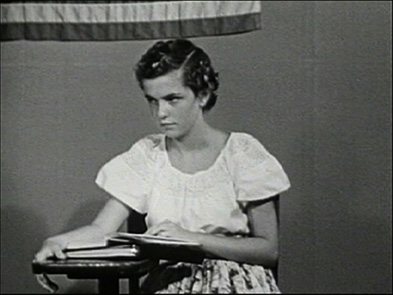
Jessica Bardsley
The Blazing World
Doc. expérimental | dv | noir et blanc | 20:0 | USA | 2012
Inflected with a feminist sensibility, The Blazing World is an essay film composed of a variety of visual and sonic stolen materials. Through an associative logic, The Blazing World enacts a meditation on shoplifting, depression, gender, Winona Ryder, and the filmmaker`s own experiences with stealing and mental health. Stealing by women becomes a form of rebellion against social and economic oppression, while also failing to provide the mental and emotional solace sought after in the accumulation of goods.
My moving image works have screened internationally at the European Media Arts Festival, Images Festival, Kassel Dokfest, Big Sky Documentary Film Festival, Antimatter Film Festival, Jihlava International Documentary Film Festival, Rooftop Films, and more. My experimental documentary The Art of Catching was awarded a 2010 Princess Grace Award in Film, as well as Director?s Choice Award at the 2011 Black Maria Film and Video Festival, Grand Prix at 25FPS Experimental Film and Video Festival, and a nomination for the New Visions Award at the 2011 Copenhagen International Documentary Film Festival (CPH:DOX). Additionally, I have been the recipient of numerous fellowships, grants and scholarships, including a 2011 Flaherty Film Seminar Student Fellowship. Currently I am a 2012-2013 Artist Resident with HATCH Project, a program of the Chicago Artists Coalition.

Scott Barley
Sleep Has Her House
Doc. expérimental | mp4 | couleur | 90:0 | Royaume-Uni | 2017
The shadows of screams climb beyond the hills. It has happened before. But this will be the last time. The last few sense it, withdrawing deep into the forest. They cry out into the black, as the shadows pass away, into the ground. Through long static takes, the film develops a contemplative, hypnotic experience, akin to paintings that move, mixing live action and still photography (shot on iPhone) and hand-drawn images.
Scott Barley is a British artist and filmmaker from South Wales, UK. His work has been screened across Europe and The Americas, including The Institute of Contemporary Arts London, BFI Southbank, Sheffield Doc Fest, Doclisboa, Karlovy Vary IFF, Dokufest, EYE Filmmuseum, Vancouver International Film Centre, Museum of Modern Art Rio, Museum of Contemporary Art Buenos Aires, and Fronteira International Documentary & Experimental Film Festival. His work has been associated with the Remodernist and Slow Cinema movements. His films are primarily concerned with the Anthropocene, nature, cosmology, phenomenology, and mysticism, and have been compared with the sensibilities of Stan Brakhage, Philippe Grandrieux, Béla Tarr, Maya Deren, and Jean Epstein.

Amie Barouh
Okinawa
Installation vidéo | mov | couleur | 27:32 | France, Japon | 2023
À la rencontre de voix, de visages et de paysages, le film okinawa est une traversée à la fois documentaire et onirique dans l’épaisseur spatiale et temporelle d’un archipel aux confins du Japon et de ses enjeux géopolitiques et environnementaux.
Amie Barouh défend un documentaire expérimental s’attachant à donner la parole à des personnes évoluant dans les marges à l’instar de la communauté Rom. Son travail relève ouvertement d’un journal filmé et s’inscrit dans l’idée que tout savoir est situé, que tout cinéma, aussi informatif soit-il, est forcément subjectif. Motivés plus par des affinités que par une volonté dogmatique de « faire cinéma », les films d’Amie Barouh, entre documentaires et essais visuels, visent avant tout à transmettre une expérience, prise comme telle, et partent souvent d’un événement marquant la vie de l’artiste, à l’instar d’une rencontre. Amie Barouh ne se contente pas d’observer ceux et celles qu’elle filme. Elle vit ou a tissé un lien particulier avec eux·elles. Mue par la curiosité et l’envie de rencontrer des membres de la communauté Rom, l’artiste se fait « adopter » par une famille et intégre leur camp en banlieue parisienne. C’est en vivant avec eux, et après 2 ans de vie commune, qu’elle commence à les filmer. Ne cherchant pas à masquer les marques d’expression subjectives, les vidéos d’Amie Barouh rompent complètement avec l’illusion d’objectivité documentaire. L’artiste met non seulement en jeu son histoire personnelle, mais aussi son corps dans la matière de ses documentaires. C’est particulièrement le cas dans Je peux changer mais pas à 100%, une œuvre qui retrace sa relation amoureuse échouée avec Bobby, un Rom roumain consommateur de crack et vivant dans la rue de menus larcins. Les films d’Amie Barouh sont toujours tendus par la recherche d’une juste proximité avec les personnes dont elle capture l’image. La « bonne » distance reste cependant toujours instable pour le plus grand plaisir du spectateur. La caméra, troisième œil et troisième bras de l’artiste, négocie en temps réel la nature des relations qu’elle – en tant que documentariste mais avant tout en tant que personne – entretient avec ses sujets. La mise en scène et le montage subjectif épousent ses élans du cœur, d’où le caractère tantôt impressionniste, tantôt réaliste des images, restituant toute la complexité à documenter des mondes auxquels on n’appartient pas. Elodie Royer. Élodie Royer Biographie Élodie Royer est commissaire d’exposition indépendante, doctorante en recherche-création à l'ENS au sein du laboratoire SACRe. Sous forme d!entretiens, de textes et d!expositions, ses recherches actuelles s’attachent à relier des pratiques d’artistes femmes au Japon en regard de leur ancrage dans des milieux de vie bouleversés par des désordres environnementaux, de l’histoire des catastrophes et de l’écoféminisme. Depuis sa résidence à la Villa Kujoyama à Kyoto en 2011, elle travaille de façon régulière sur et avec la scène artistique japonaise. En 2022, elle a conçu l’exposition Les Êtres Lieux à la Maison de la culture du Japon, et entre 2016 et 2020, une série d’expositions commissionnée par KADIST et le MOT Musée d’art contemporain de Tokyo en collaboration avec Che Kyongfa (Things Entangling, MOT; Les nucléaires et les choses, KADIST; Almost nothing, yet not nothing, Tokyo University of the Arts). Elle est aussi membre des comités d’acquisition de la Fondation KADIST et du FRAC Rhône-Alpes ; et des comités éditoriaux de TextWork, plateforme éditoriale de la Fondation d’entreprise Pernod Ricard et de PALM, magazine en ligne du Jeu de Paume. Auparavant, elle a conçu des expositions au sein de nombreuses structures d’art contemporain publique et privée en France (Palais de Tokyo, Le Plateau/FRAC Ile-de-France, gb agency, DOC!, etc.) et à l’international (Mercer Union à Toronto, Tate Modern à Londres, GAMeC – Galerie d’art moderne et contemporain à Bergame, etc.). Avec le commissaire d’exposition Yoann Gourmel, elle a notamment mis en place le programme 220 jours en 2007- 2008, en dialogue avec les artistes Isabelle Cornaro, Julien Crépieux, Mark Geffriaud, Benoît Maire, Bruno Persat, Chloé Quenum ou Raphaël Zarka: http://220jours.blogspot.com/.

Amie Barouh
Je peux changer mais pas à 100%
Documentaire | mov | couleur | 40:24 | France | 2019
Le film commence par une promesse amoureuse: je peux changer. Une promesse trop souvent entendue, une promesse que l’on sait fausse d’avance. Amie est tombée profondément amoureuse de Bobby, un jeune homme Rom roumain, qui vit dans la rue et qui aime par-dessus tout l'héroïne. Ensemble, ils ont vécu, entre le parking de la Gare de Lyon et des petits hôtels parisiens, une folle histoire d’amour, qui n’a pourtant pas réussi à faire changer Bobby. Car il aime la liberté de la rue, où il a grandi, la seule forme de foyer qu’il connaisse. Amie, jeune femme franco-japonaise élevée dans un milieu d’artistes cosmopolites, a fait de ce chagrin d’amour une chronique déchirante sur leur relation impossible. "Je peux changer mais pas à 100%" est un récit d’une intimité brutale, hors norme, qui nous invite à découvrir les sous-sols impénétrables et la communauté qui y habite, sans préjugés. Complètement démunie par l’échec de son amour, qui n’a pas été suffisamment fort pour faire changer Bobby, la réalisatrice utilise le cinéma comme seul moyen pour soigner sa blessure. Ou, peut-être, pour écrire une lettre d’amour déchirante à celui qui ne lit pas, mais qui parle toutes les langues. Et nous, nous en sommes les témoins privilégiés.
Amie Barouh est née à Tokyo (Japon) en 1993. Elle s'installe à Paris (France) en 2010, où elle étudie la peinture à l'école des Beaux-Arts. C'est aussi dans la capitale française qu'elle découvre la culture Rom. Elle fait la rencontre d'une famille, et se fait accepter dans la communauté. Parallèlement à ses études aux Beaux-Arts, elle vit dans un camps de Rom sous le pont de Jointville-Le-Pont (France), et commence rapidement à apprendre le romani et le roumain. Un jour, un des membres de la famille lui demande de filmer un mariage. Depuis, elle utilise la caméra comme moyen d'expression. "Je peux changer, mais pas à 100%" est son premier film.
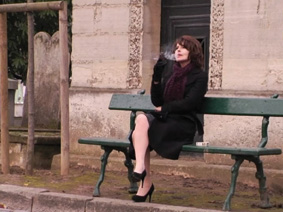

Antoine Barraud
RIVER OF ANGER
Doc. expérimental | dv | couleur et n&b | 38:0 | France | 2008
Le réalisateur états-unien phare de l?underground évoque ses anciens rêves et cette évocation déclenche un flot de paroles, une rivière...
Né en 1971, il se met en scène dans son premier court métrage "Monstre" en 2003 (présenté aux festivals d?Angers, Moncton, Sarajevo, Taipei, Clermont-Ferrand?). En 2005, il part à Taiwan réaliser "Song" avec Lu Yi Ching (l?actrice fétiche de Tsaï Ming Liang), Nathalie Boutefeu et Nobuhiro Suwa, le réalisateur japonais de "M/other". En 2007, il réalise "Monstre, numéro deux" avec à nouveau Nathalie Boutefeu ainsi qu?un portrait du cinéaste légendaire américain Kenneth Anger, "River of Anger". Pour "Twenty Puccini" (un projet du lucca film festival) il transpose une partie de "Turandot" dans une immense orgie.
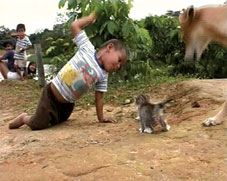

Cecilia Barriga
El origen de la violencia
Vidéo expérimentale | dv | couleur | 1:0 | Espagne | 2004
Un jeune garçon joue avec un petit chat, et soudain, il transforme ce jeu agréable en un acte de haine incontrôlé. Cette vidéo d'une minute nous amène à réfléchir sur l'origine de la violence.
Cecilia Barriga est né au Chili. En 1977, elle s'est installée en Espagne, à Madrid. Ces vingt dernières années, elle a travaillé sur différents supports visuels, tels que des films, de l'art vidéo, des documentaires et des longs-métrages. Ses créations les plus importantes sont les suivantes: 1991 "Meeting two queens," oeuvre expérimentale majeure présentée au MOMA, New York, Whitney Museum, Reina Sofia, Guggenheim Museum et dans de nombreuses universités à travers le monde. 2000 "Time's up!", long-métrage sortie en salle à Paris, Madrid et présenté dans de nombreux festivals, notamment au San Sebastian International Film festival. Parmi ces créations récentes, on trouve "El camino de Moises" (2004), un documentaire qui a été couronné de succès à la télévision espagnole. "The origine of violence" (2006) a été présenté dans les musées d'art les plus importants d'Espagne.